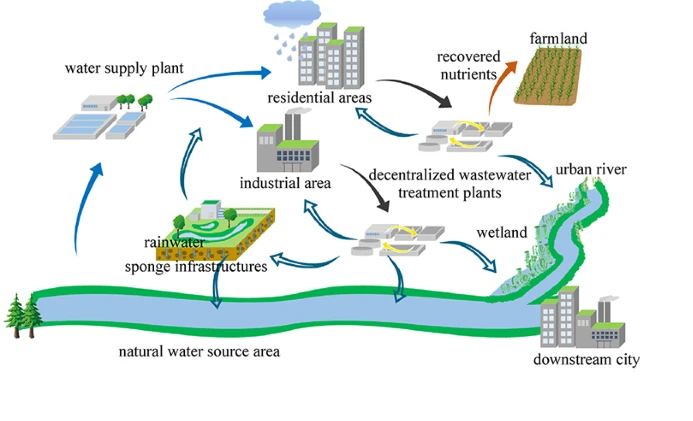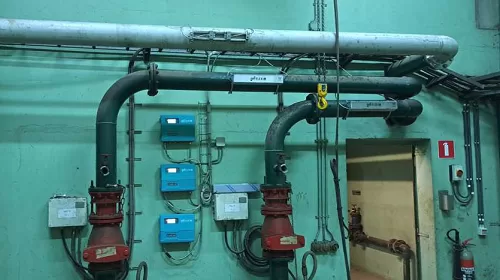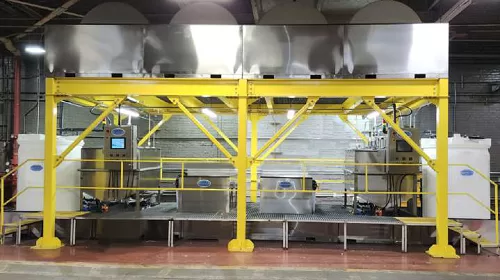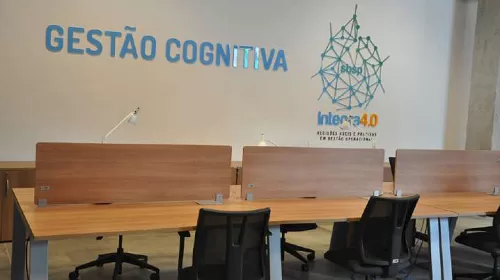By Dilip Yewalekar & Manisha Kinge
Rapid urbanization-industrialization in Bharat have a considerable impact on water demand. Changes in food consumption, lifestyle, and land use patterns also play a major role in water requirements and management. Although Bharat received plenty of water as rainfall during monsoon, due to lack of storage only a small percentage of that water is added to the reserve. There is a significant mismatch between the spatial distributions of available water with the population, the situation becomes alarming, and ironically less water is available where more people live. As per the international norms, countries with per capita water availability of less than 1,700 m3 per year are categorized as water stress, Bharat falls under water stress country because 1,545 m3 water per capita available. Studies show that the projected water availability will become 1401 m3 in 2025 and 1191 in 2050. Average domestic water demand would also increase from 86 litre per capita per day in 2000 and 125 litre per capita per day in 2025 and 170 lpcd in 2050. Total industrial water demand is also increased 92 bcm by 2025 and 161 CMC 2050. Therefore, it is necessary to implement integrated urban and industrial water management policy.
What is integrated water management for Urban and Industrial?
Integrated Urban and Industrial water management is the practice of planning and managing freshwater, wastewater, and rainwater for various applications and uses. This means consideration of water supply and sanitation within an urban and industrial sector by incorporating various scopes of utility technology. By introducing various water management techniques, urban and industrial areas can contribute to the sustainable use and conservation of water resources, helping to create resilient and water-secure communities. Table 1. Shows the water demand for various sectors in Bharat.
Table 1. Sector-wise water demand in Bharat [Ref-PIB 2013]
| Sector | 2010 | 2025 | 2050 | |||
| High | Low | High | Low | High | Low | |
| Irrigation | 543 | 557 | 561 | 611 | 628 | 807 |
| Drinking | 42 | 43 | 55 | 62 | 90 | 111 |
| Industry | 37 | 37 | 67 | 67 | 81 | 81 |
| Energy | 18 | 19 | 31 | 33 | 63 | 70 |
| Others | 54 | 54 | 70 | 70 | 111 | 111 |
| Total | 694 | 710 | 784 | 843 | 973 | 1180 |
Water for Survival
Water is essential for human, plants, live beings for survival and plays an important role in many sectors of the economy. However, water resources are irregularly distributed in space and time, and they are under pressure due to human activity and economic development. Accelerated urbanization-industrialization and the expansion of municipal water supply and sanitation systems also contribute to the rising water demand. Furthermore, climate change scenarios project spatial and temporal variations of water cycle dynamics, which exacerbate the discrepancies between water supply and demand. Water for irrigation and food production constitutes one of the greatest pressures on freshwater resources, with agriculture accounting for over 70 percent of global freshwater withdrawals and up to 90 percent in some fast-growing economies.
Managing water is a global challenge that impacts the environmental, social, economic, and political cornerstones of our existence on Earth. Effluent reclamation and reuse provide opportunities to conserve water and maintain the quality of the existing freshwater suppliers. Water reuse for various purposes is increasing practically throughout the world. It is meant to help close the anthropogenic water cycle and enable sustainable reuse of available water resources. When integrated into water resources management, it can be considered an integral part of pollution control and water management strategies.
As freshwater supplies become more limited and economic development comes with increasing water demand, technologies such as desalination and water reuse are often recognized as solutions with great potential to reduce the gap between availability and demand. However, on a larger scale, brine released from desalination plants includes chemical residues that negatively affect ecosystems. Furthermore, although desalination may solve the problem of water scarcity in water-stressed areas, there still lies the problem of associated wastewater management and the costs involved. The ability to reuse water, regardless of whether the intent is the augment water supplies or manage nutrients in treated effluent has positive benefits that are also the key motivators for implementing reuse programs. These benefits include improved agricultural production, reduced energy consumption associated with the production, treatment, and distribution of water, and significant environmental benefits. Even though reclaimed water reuse is currently implemented in many countries, its potential has not yet been exploited in many areas, and the proportion of water reuse in total wastewater generation is still small. This emerging worldview that considers that a third industrial revolution is underway, supported by the age of the internet, IOT, IT facilitates the exchange of ideas to use finance to create a circular economy in water cycle-recycle-reuse.
Integrated Urban & Industrial Water Management aims at designing, managing the urban water system holistically. This section provides a basic introduction to the notion of integration water management and describes how it can help in the long run to use water resources more sustainably.
Urban and Industrial sustainable water management is crucial for ensuring the availability and quality of water resources in the face of growing urbanization and industrial activities. Integrated water management involves the responsible use, conservation, & protection of water sources to meet current needs without compromising the ability of future generations to meet their own needs. Table 2. Indicates types of water, treatment before use and its uses/application for various purpose
Table 2. Water types-Treatment-Uses.
| Sr. | Type of water | Treatment before use | Uses/applications |
| 1. | Surface water | Pre-filtration, Sedimentation, coagulation, UV treatment, Chlorination, | Domestic, industrial, agricultural. |
| 2. | Groundwater | Filtration, UV Treatment, chlorination | Domestic, industrial, and agriculture. |
| 3. | Salt water[sea water] | Desalination | Domestic, Industrial |
| 4. | Frozen water | Heating, Filtration, UV Filter | Domestic, Industrial |
| 5. | Atmospheric water | Filtration, UV treatment | Domestic, Agriculture |
| 6. | Waste water | Pre-filtration, Sedimentation, Coagulation, UV treatment, Chlorination | Landscape, garden. |
| 7. | Brackish water | Pre-filtration, Sedimentation, Coagulation, UV treatment, Chlorination | Landscape, Garden |
| 8. | Mineral water | Filtration, UV treatment | Drinking water. |
| 9. | Distilled water | UV treatment, add mineralization | Drinking water, battery, Nuclear reactor. |
| 10. | Rain water | Filtration, UV treatment, chlorination | Domestic, agriculture |
Water Reuse and Recycle-Circular Economy
Fig.1. Water Cycle-Re-cycle-Re-Use-Circular Economy
Water reuse and recycling offer several benefits, both to us and to the world (fig.1). The biggest benefit comes from preventing water shortages. That offers protection to the world’s water resources, which would get drained to ensure that humans can continue to prosper while we run out of water. Recycling also ensures that we have enough water to grow crops, maintain our hygiene, and simply stay hydrated and run industries. Almost every aspect of human life uses water at some point, so running out could cause our entire civilization to collapse.
Recycling also helps to prevent pollution, especially in an industrial context. Many machines and appliances produce wastewater that carries some pollutants. If that water enters the environment without treatment, it can spread those pollutants across a surprising distance and give them a chance to kill plants and animals. Wastewater treatment and water recycling prevent the water from contamination our rivers, lakes, and groundwater.
Here are some key considerations for urban and industrial water management;
- Water Efficiency and Conservation
- Implementing water-efficient technologies and practices in urban and industrial settings can significantly reduce water consumption.
- Encouraging the adoption of water-saving appliances and fixtures in urban areas and promoting water recycling and reuse in industries.
- Stormwater management
- Designing and implementing effective stormwater management systems in urban areas to reduce runoff and prevent flooding.
- Incorporating green infrastructure, such as permeable pavements and green roofs, to enhance storm water absorption and reduce the burden on conventional drainage systems.
- Wastewater Treatment and reuse.
- Developing advanced wastewater treatment technologies for both urban and industrial to ensure that treated meets high-quality standards.
- Promoting the safe and sustainable reuse of treated wastewater for non-portable purposes, such as irrigation, industrial processes, or cooling
- Integrated Water Resource management
- Adopting an integrated approach that considers the interconnectedness of water resources, including surface, groundwater, and rainwater harvesting.
- Collaborating with stakeholders across sectors to develop comprehensive water management plans that address the needs of both urban and industrial areas.
- Community Engagement and education
- Raising awareness among urban residents and industrial stakeholders about the importance of water conservation and sustainable practices
- Involving local communities in planning and decision-making processes related to water management to ensure their needs and concerns are considered.
- Policy and Regulations
- Implementing and enforcing water related regulations and standards to ensure responsible water use in both urban and industrial contexts.
- Encouraging the development of policies that promote sustainability, innovation, and responsible water stewardship.
- Technological innovation
- Investing in research and development of new technologies that improve water management efficiency, such as smart water meters, sensors, and data analytics for real-time monitoring.
- Climate change adaption
- Considering the potential impacts of climate change on water resources and developing adaptive strategies to address changing precipitation patterns, rising temperatures, and extreme weather events.
- Public-Private Partnerships [PPP]
- Facilitating collaborations between public and private entities to fund and implement sustainable water management projects.
- Research and innovations
- Invest in research and development to explore new technologies and innovative solutions for water management
- Foster a culture of innovation to continuously improve water efficiency and sustainability.
Climate change and its implications on water
Changes in temperature and precipitation due to global warming and related processes have serious impacts on hydrologic processes and the regional water resources of Bharat. Climate affects the supply and demand of water and its quality, especially in arid and semi-arid areas. IPCC AR5 reports that the mean annual temperature is increasing all over Asia and it is projected to increase by 200C till the end of the 21st Century (BAU Scenerio-Hijioka-2014). Rising temperature contributes to glacial melts resulting in glacier retreat and affecting the water availability in the Himalayan River thus threatening the water supplies on which hundreds of millions of people depend. Almost 67 percent of the glaciers in the Himalayan mountain ranges have retreated in the past decade due to warming effects. Any shortfall in the supply of water will have a multi-fold impact on the social, environmental, industrial, and economic well-being affected area. As water availability is becoming less predictable, drought situations in some parts of India are more likely in the future. Water scarcity not only has an immediate effect on agricultural productivity but also has an impact on industries and a long-term impact on the socio-economics of the affected area. In a nutshell, considering reports from various agencies, it is necessary to plan and implement integrated water management for urban and industrial sectors from today!





